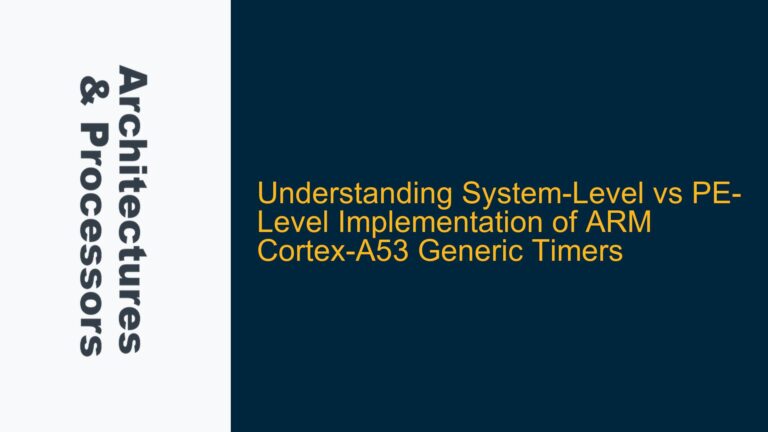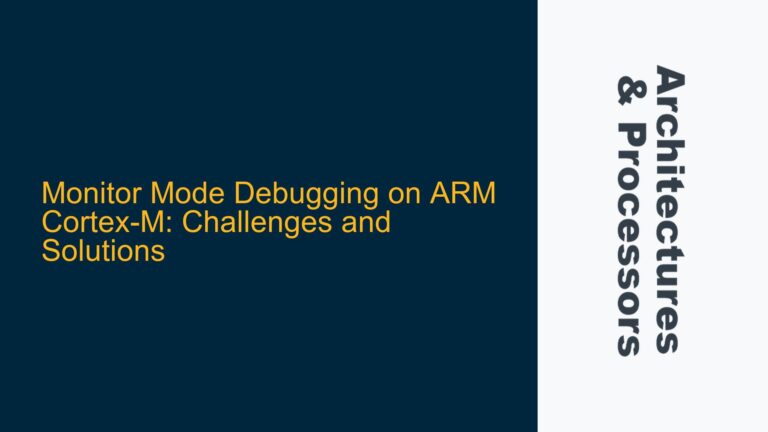ARM Cortex-A35 Low-Power Mode Transition Latency and Cache Coherency
The ARM Cortex-A35 is a highly efficient processor designed for low-power applications, often used in embedded systems where energy efficiency is critical. One of the key features of the Cortex-A35 is its ability to transition into low-power modes to conserve energy. However, these transitions are not instantaneous and involve complex interactions between the processor, caches, and memory subsystems. Understanding the latency associated with entering and exiting low-power modes, especially when maintaining L1 and L2 cache coherency, is crucial for system designers aiming to optimize power consumption without compromising performance.
The latency of power mode transitions in the Cortex-A35 is influenced by several factors, including the state of the caches, the specific low-power mode being entered, and the configuration of the system-on-chip (SoC). When the processor enters a low-power mode, the caches (L1 and L2) may need to be flushed or invalidated to ensure data coherency. This process can significantly impact the transition latency. Similarly, when exiting a low-power mode, the caches must be restored or reinitialized, which also contributes to the exit latency.
The challenge lies in accurately estimating these latencies, as they are highly dependent on the specific implementation of the SoC. The Cortex-A35 core itself provides certain guidelines, but the actual latencies can vary based on the SoC vendor’s implementation, the memory subsystem, and the power management unit (PMU). Additionally, maintaining cache coherency during these transitions adds another layer of complexity, as the caches must be managed carefully to avoid data corruption or loss.
Factors Influencing Power Mode Transition Latency in Cortex-A35
The latency associated with power mode transitions in the Cortex-A35 is influenced by a combination of hardware and software factors. These factors include the specific low-power mode being used, the state of the caches, the configuration of the memory subsystem, and the implementation of the power management unit (PMU) in the SoC.
Low-Power Mode Selection: The Cortex-A35 supports multiple low-power modes, each with different levels of power savings and associated transition latencies. For example, the "Wait for Interrupt" (WFI) mode is a shallow low-power mode that allows the processor to quickly resume operation, while deeper low-power modes such as "Standby" or "Power Down" require more time to enter and exit due to the need to save and restore the processor state.
Cache State and Coherency: The state of the L1 and L2 caches plays a significant role in determining the transition latency. If the caches contain dirty data (i.e., data that has been modified but not yet written back to main memory), they must be flushed before entering a low-power mode to ensure data coherency. This flushing process can add significant latency to the transition. Similarly, when exiting a low-power mode, the caches may need to be invalidated or reinitialized, which also contributes to the exit latency.
Memory Subsystem Configuration: The configuration of the memory subsystem, including the type of memory (e.g., SRAM, DRAM) and the memory controller, can impact the transition latency. For example, if the memory subsystem is configured to enter a low-power mode along with the processor, additional time may be required to wake up the memory subsystem when exiting the low-power mode.
Power Management Unit (PMU) Implementation: The PMU in the SoC is responsible for managing the power modes of the processor and other system components. The specific implementation of the PMU, including the sequence of operations it performs during power mode transitions, can have a significant impact on the transition latency. Some PMUs may perform additional checks or optimizations that can reduce the latency, while others may introduce additional delays.
System Clock and PLL Configuration: The system clock and phase-locked loop (PLL) configuration also play a role in determining the transition latency. When entering a low-power mode, the system clock may be gated or the PLL may be turned off to save power. When exiting the low-power mode, the clock must be restored and the PLL must be relocked, which can add to the exit latency. The time required for the PLL to lock can vary depending on the specific implementation and configuration.
Estimating and Optimizing Cortex-A35 Power Mode Transition Latency
Accurately estimating and optimizing the power mode transition latency in the Cortex-A35 requires a detailed understanding of the specific SoC implementation and the system configuration. The following steps provide a structured approach to estimating and optimizing the transition latency:
Step 1: Identify the Specific Low-Power Mode and SoC Configuration: The first step is to identify the specific low-power mode being used and the configuration of the SoC. This includes understanding the state of the caches, the memory subsystem configuration, and the PMU implementation. The SoC vendor’s documentation should provide detailed information on the power mode transition sequences and the associated latencies.
Step 2: Measure the Transition Latency: Once the specific low-power mode and SoC configuration have been identified, the next step is to measure the actual transition latency. This can be done using performance counters or timers available in the Cortex-A35. By measuring the time taken to enter and exit the low-power mode, you can obtain a baseline estimate of the transition latency.
Step 3: Analyze the Cache State and Coherency Requirements: The state of the caches and the coherency requirements must be analyzed to determine their impact on the transition latency. If the caches contain dirty data, they must be flushed before entering the low-power mode. Similarly, when exiting the low-power mode, the caches may need to be invalidated or reinitialized. The time required for these operations should be included in the overall transition latency estimate.
Step 4: Optimize the Cache Management: To minimize the impact of cache management on the transition latency, it is important to optimize the cache management strategy. This may involve reducing the amount of dirty data in the caches before entering the low-power mode, or using cache maintenance operations to selectively flush or invalidate only the necessary cache lines. Additionally, using cache retention techniques, where the cache contents are preserved during the low-power mode, can reduce the need for cache reinitialization when exiting the low-power mode.
Step 5: Optimize the Memory Subsystem Configuration: The memory subsystem configuration should be optimized to minimize the impact on the transition latency. This may involve configuring the memory subsystem to enter a low-power mode that allows for quick wake-up, or using memory types that have faster access times. Additionally, the memory controller should be configured to minimize the time required to restore the memory subsystem when exiting the low-power mode.
Step 6: Optimize the PMU and Clock Configuration: The PMU and clock configuration should be optimized to reduce the transition latency. This may involve configuring the PMU to perform power mode transitions more efficiently, or using clock gating techniques to reduce the time required to restore the system clock when exiting the low-power mode. Additionally, the PLL configuration should be optimized to minimize the time required for the PLL to lock when exiting the low-power mode.
Step 7: Validate the Optimized Configuration: Once the cache management, memory subsystem, PMU, and clock configuration have been optimized, the transition latency should be re-measured to validate the improvements. This may involve iterating through the optimization steps to further reduce the transition latency.
Step 8: Document the Findings and Best Practices: Finally, the findings and best practices should be documented to provide guidance for future system designs. This documentation should include the specific low-power mode, SoC configuration, cache management strategy, memory subsystem configuration, PMU and clock configuration, and the measured transition latencies. This documentation will serve as a valuable resource for optimizing power mode transitions in future Cortex-A35-based systems.
By following these steps, system designers can accurately estimate and optimize the power mode transition latency in the Cortex-A35, ensuring that the system achieves the desired balance between power savings and performance.






